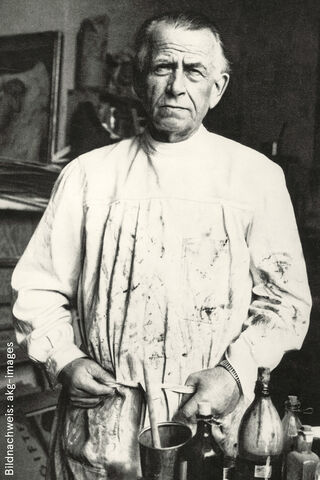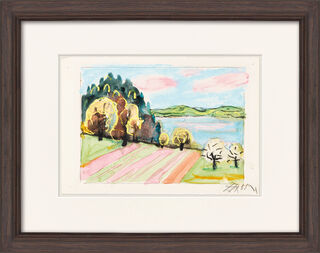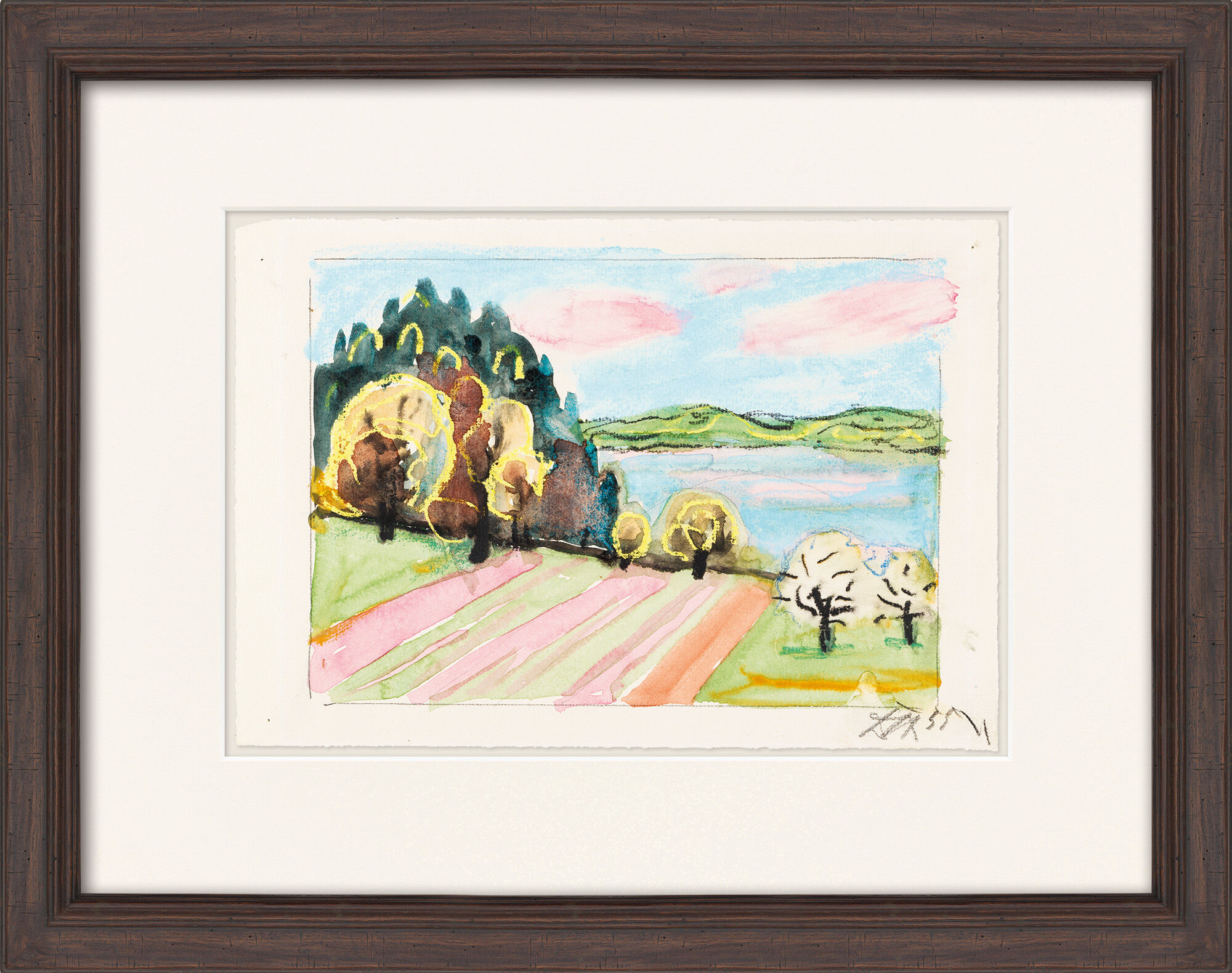Picture "Lake Constance - Farmland" (1955) (Unique piece) New


Picture "Lake Constance - Farmland" (1955) (Unique piece) New
Quick info
unique piece | signed | dated | watercolour on paper | framed | size 43 x 49 cm
Detailed description
Picture "Lake Constance - Farmland" (1955) (Unique piece)
In 1936, Otto Dix retreated to Hemmenhofen by Lake Constance with his wife Martha and their children, where he lived until he died in 1969. There, he increasingly focussed on landscape painting. His home and studio building offered a direct view of the lake and was located not far from the opposite Swiss shore. Inspired by these idyllic surroundings and the impressive, diverse landscape, he created atmospheric landscape paintings in the 1950s.
Otto Dix's late creative phase is dominated by the techniques of alla prima painting, watercolour and lithography. His graphic work is particularly appealing due to its immediacy and visible spontaneity, reflecting the unadulterated expression of subjective experience.
The "Catalogue Raisonné of Watercolors and Gouaches," reads as follows: "The intertwining between artist and subject is closely linked in his watercolours, sympathies become apparent, Dix lets his temperament prevail. The distance is shorter, enabling a sensitive reaction, and thus the uncensored results of his restless search emerge as a subjective response to the environment. [...] When painting watercolours, Dix lets himself drift, communicating his nature unrestrainedly, his sensual stimulus [...]."
Watercolour and coloured chalk on paper, 1955, signed and dated lower right. Catalogue raisonné Pfäffle no. A 1955/19. Motif size/sheet size 18.8 x 25.5 cm. Size in frame 43 x 49 cm as shown.

About Otto Dix
1891-1969
Otto Dix, born in Gera, Germany in 1891, studied at the Dresden Academy of Fine Arts and Crafts and served as a volunteer for the German Army in the First World War. During this time, he produced gouaches and drawings that focused on the events of the war. When he returned he studied again.
After experimenting artistically with Expressionism, Futurism and Dadaism, Dix finally found his style in an exaggerated Realism with which he held up a mirror to society. As one of the main protagonists of New Objectivity, Dix became one of the most famous German artists and one of the chroniclers of his time. World-famous is his "Big City Triptych" (1927/28), with which Dix created a classic of the New Objectivity.
In 1933, Dix lost his professorship at the Academy of Fine Arts in Dresden due to degeneration by the Nazis, whereupon he moved to the south of Germany, where he mainly created landscape paintings.
In his late work after 1945, Dix returned to the expressionist style of his early years and turned from glaze painting to wet-on-wet painting and lithographs. His late graphic work includes portraits of animal with experimental lines and colouring, showing a series of technically different, expressive works with the same motif – cat and rooster. From 1949 onwards he began to discover the rooster as one of his motif, which appeared repeatedly in his works in the following years, for example in the pencil drawings on watercolour handmade paper "Lake Constance, Landscape with Rooster" from 1954 and "Rooster before Sunrise" from 1950-1955 as well as "Peter and the Rooster", a colour lithograph from 1958.
His ambivalent, as well as committed realism, has not lost its explosive power to this day. "I strive to arrive at the sense of our time in my paintings, because I believe that a painting must above all address a content, a theme. Painting is an attempt to create order, art for me is banishment."
Paintings with glazing watercolours, that are characterised by their transparency, which let deeper layers and painting surfaces shine through.
Often the paper surface is omitted. This contributes significantly to the effect of the work. The aquarelle painting requires skilful use of colour, as it dries quickly and corrections are almost impossible.
A one-of-a-kind or unique piece is a work of art that has been personally created by the artist. It exists only once due to the type of production (oil painting, watercolours, drawing, etc.).
In addition to the classic unique pieces, there exist the so-called "serial unique pieces". They present a series of works with the same colour, motif and technique, manually prepared by the same artist. The serial unique pieces are rooted in "serial art", a type of modern art, that aims to create an aesthetic effect through series, repetitions and variations of the same objects or themes or a system of constant and variable elements or principles.
In the history of arts, the starting point of this trend was the work "Les Meules" (1890/1891) by Claude Monet, in which for the first time a series was created that went beyond a mere group of works. The other artists, who addressed to the serial art, include Claude Monet, Piet Mondrian and above all Gerhard Richter.


